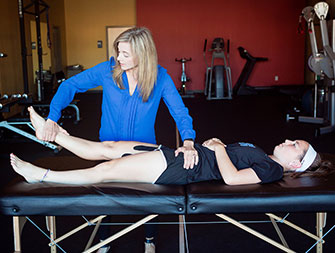
Deep tissue Massage is a type of massage therapy that involves applying firm pressure and slow strokes to reach deeper layers of muscle and fascia (the connective tissue surrounding muscles). It’s used for chronic aches and pain and contracted areas such as a stiff neck and upper back, low back pain, leg muscle tightness, and sore shoulders.
Deep tissue massage techniques are used to break up scar tissue and physically break down muscle “knots” or adhesions (bands of painful, rigid tissue) that can disrupt circulation and cause pain, limited range of motion, and inflammation.
| 30 min massage | $35 |
| 45 min massage | $50 |
| 60 min massage | $65 |
Book an appointment and begin feeling better starting today
Deep tissue massage is more than just a massage with deep pressure. The goals and techniques are different from a Swedish massage. While it may help with certain conditions, remember that massage doesn’t always have to hurt or make your body sore to be effective. To get the most out of your massage, communicate with your Massage therapist.
Deep tissue massage typically focuses on a specific problem, such as chronic muscle pain, injury rehabilitation, and the following conditions:
Not all of these benefits have been scientifically proven. But if you are interested in a massage to prevent sports injury, address sport-specific concerns, or to help with muscle recovery after sports, consider asking Yaxita Patel your therapist about getting a Sports Massage.
At certain times during the massage, you may feel some discomfort or even some pain as the massage therapist works on areas where there are adhesions or scar tissue.
Pain isn’t necessarily good, and it’s not a sign that the massage will be effective. In fact, your body may tense up in response to pain, making it harder for the therapist to reach deeper muscles.
You should always tell your massage therapist if you feel pain during the massage. The therapist can adjust the technique or further prep the tissues if the superficial muscles are tense.
Possible side effects and Precautions
Deep tissue massage may not be safe for people with blood clots (e.g. thrombophlebitis or deep vein thrombosis), due to the risk that they may become dislodged.
If you have blood clots or are at risk of forming blood clots, it’s essential that you consult your doctor before getting a deep tissue massage.
If you’ve had recent surgery, chemotherapy, radiation, or have another medical condition, it’s wise to check with your doctor before starting massage therapy. Some people with osteoporosis should avoid the deeper pressure of this type of massage.
Massage should not be done directly over bruises, inflamed or infected skin, skin rashes, unhealed or open wounds, tumours, abdominal hernia, fragile bones, or areas of recent fractures. Massage may cause bruising and rarely, hematoma (a localized collection of blood outside of blood cells), venous thromboembolism and a condition known as spinal accessory neuropathy.
If you have any condition, it’s important to consult your primary care provider first to find out what type they recommend. For example, people with certain conditions, such as ankylosing spondylitis, may not be able to tolerate the pain of a deep tissue massage.
If you are pregnant, you should check with your doctor if you are considering getting a message. Deep tissue massage (or any strong pressure) should be avoided during pregnancy, but your doctor may suggest a massage therapist trained in pregnancy massage instead. We suggest speaking With Yaxita about Pregnancy massage. Deep tissue massage may also result in bruising. Case reports have reported venous thromboembolism, spinal accessory neuropathy, hepatic hematoma, and posterior interosseous syndrome after deep tissue massage.